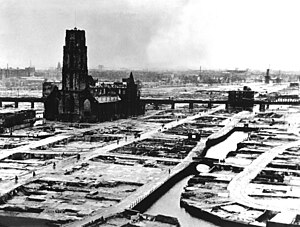| The Rotterdam Blitz | |||||||
|---|---|---|---|---|---|---|---|
| Part of the German invasion of the Netherlands | |||||||
 Rotterdam's city centre after the bombing. The heavily damaged (now restored) St. Lawrence church stands out as the only remaining building that is reminiscent of Rotterdam's medieval architecture. The photo was taken after the removal of all debris. | |||||||
| |||||||
| Belligerents | |||||||
|
|
| ||||||
| Commanders and leaders | |||||||
| P. W. Scharroo | Albert Kesselring | ||||||
| Units involved | |||||||
|
Luchtvaartafdeling (LVA) Marineluchtvaartdienst (MLD) | Luftflotte 2 | ||||||
| Strength | |||||||
| No remaining operational fighter aircraft[1] |
80 aircraft directly involved 700 involved in concurrent operations | ||||||
| Casualties and losses | |||||||
|
1,150 killed, including 210 soldiers[2] LVA and MLD virtually destroyed[3] | 125[2] | ||||||
In 1940, Rotterdam was subjected to heavy aerial bombardment by the Luftwaffe during the German invasion of the Netherlands during the Second World War. The objective was to support the German troops fighting in the city, break Dutch resistance and force the Dutch army to surrender. Bombing began at the outset of hostilities on 10 May and culminated with the destruction of the entire historic city centre on 14 May,[2] an event sometimes referred to as the Rotterdam Blitz. According to an official list published in 2022, at least 1,150 people were killed, with 711 deaths in the 14 May bombing alone,[2] and 85,000 more were left homeless.
The psychological and the physical success of the raid, from the German perspective, led the Oberkommando der Luftwaffe (OKL) to threaten to destroy the city of Utrecht if the Dutch command did not surrender. The Dutch surrendered in the late afternoon of 14 May and signed the capitulation early the next morning.[4]
- ^ De luchtverdediging mei 1940, by F.J. Molenaar. The Hague, 1970.
- ^ a b c d "First official list of victims of Rotterdam bombing published after 82 years". DutchNews.nl. 12 April 2022. Retrieved 12 April 2022.
- ^ Hooton 2007, p. 79.
- ^ Hooton 2007, p. 52.